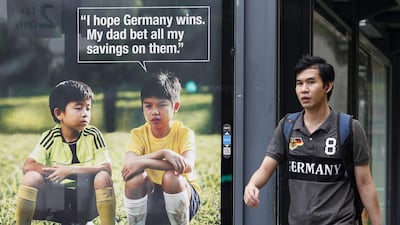Singapore tried its best to save an own goal on Monday by updating an anti-gambling ad that starred a despairing boy named Andy telling friends his dad had bet his life savings on Germany winning the World Cup.
The National Council on Problem Gambling’s commercial was lampooned around the world after Germany thrashed Brazil 7-1 in the semi-finals, sparking jokes that the ad would encourage rather than deter gambling.
The laughs got louder after Germany beat Argentina 1-0 on Sunday night with many people taking to social media to congratulate “Andy” on his family’s good fortune.
“Andy, OK you can stop smiling. Go get your savings from your daddy. Tell him please don’t do this again and you get ready for school,” Teo Ser Luck, a Trade and Industry Ministry official, wrote on Facebook.
The council swiftly put up a new version of the ad on its website, making clear Andy’s father was unlikely to be spending his winnings on a family holiday.
“Your dad’s team won,” asks Andy’s friend. “Did you get your savings back?”
“No, dad never stops ... He wants to bet one more time,” comes his reply, without specifying where he might place his next wager.
The council said last week it had chosen Germany in the ad to inject “realism” into its message and that the idea was to deter people from getting carried away by the World Cup hype.
Gambling is hugely popular in Singapore but tightly regulated, with football bets allowed to be placed only through state-owned bookmakers.
The government launched the anti-gambling council in 2005 – before it allowed two multi-billion dollar gaming resorts to open in 2010. The commercial will run until July 23.

